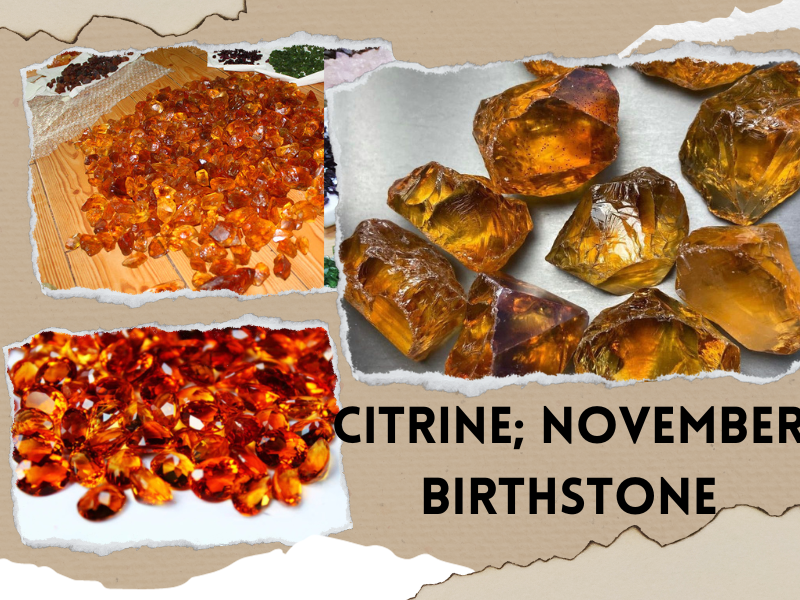Home
Know your Birthstones | Birthstones for Each Month
Citrine November Birthstone jewelry-A Golden Choice

Citrine November Birthstone jewelry-A Golden Choice
Introduction of Citrine as Birthstone
Citrine is the birthstone of November. The yellow and orange colors of citrine represent the period between autumnal equinox and winter solstice. Citrine is the traditional gift given to the life partner on 13th wedding anniversary.
Citrine Birthstone Meaning and History
The word “Citrine” is derived from French word “citron” meaning “lemon”. It is named “citrine” because its yellow color resembles that of citron or lemon.
Ancient Greeks and Romans believed that citrine was the symbol of prosperity. The Egyptians used citrine stone as talisman. Citrine was believed to be the means of manifesting one’s aspirations.
In the past, citrine was related to Sekhmet, the Egyptian goddess of war which was supposed to be the guardian angel of pharaohs.
The Romans used citrine gemstones to make intaglios.
In Scotland, citrine was used to embellish swords and the soldiers wielded them in battles.
In China, citrine was believed to be the symbol of success and generosity. It was thought to make the people wise and broadminded.
Citrine was the most favorite stone of people in the Victorian era. A gold pendant with central stone citrine was discovered and historians believe that it belongs to the mid 1800s epoch.
Citrine Stone Properties/ Chemical/ Technical Properties of Citrine Gemstone
|
Chemical Formula |
SiO2 |
|
Color |
Yellow to yellowish orange to brownish yellow |
|
Hardness |
7 on the Mohs hardness scale |
|
Refractive Index |
1.54-1.55 |
|
Streak |
White |
|
Crystal System |
Trigonal |
|
Habit |
Horizontally striated hexagonal prisms terminated by positive and negative rhombohedrons forming six sided pyramids |
|
Luster |
Vitreous |
|
Cleavage |
None |
|
Transparency |
Transparent to translucent |
|
Fracture |
Conchoidal |
|
Tenacity |
Brittle |
|
Group |
Quartz |
|
Rock type |
Granite, Pegmatites, Rhyolite and Andesite |
Where Citrine Stone is found? Give some details of countries and locations?
- Brazil: Eastern Brazil is the major source of yellow and orange colored citrine stones. Citrine is found in Menas Gerais and Rio Grande do Sul in Brazil.
- Russia: Russia is the producer of synthetic citrine gemstones. Natural citrine is found in Ural Mountains of Russia.
- Madagascar: Antananarivo province and Ilakaka region of Madagascar are the main sources of citrine.
- Zambia: Citrine is found in Mansa district of Luapula province in Zambia.
- Bolivia: Anahi ametrine mine in eastern Bolivia produces ametrine crystals which are selectively cut into citrine.
- Uruguay: Artigas is the best mining area for citrine in Uruguay.
- Spain: Citrine is mined from Villasbuenas, Salamanca province in Spain.
How Citrine Stone gets its colors? What are other colors of Citrine stones?
Citrine is yellow to yellowish orange to brownish yellow variety of quartz. Ferric iron (Fe3+) is responsible for the yellow color of citrine. Natural citrines display color zoning.
If natural citrines are heated above 200 – 500 degrees Celsius or when exposed to UV light, they become pale.
Most of the light yellow to medium yellow citrine is produced commercially by heating smoky quartz and dark yellow to orangey brown citrine is produced by heating amethyst.
Madeira Citrine: Madeira citrine resembles amber glow of Portuguese wine. It ranges in color from golden orange to reddish brown.
Fire Citrine: Fire citrine has deep red-orange tones mined from Linha Estefania Mine in Brazil. It is treated to achieve its color.
Tiger striped Citrine: When one or more fractures of citrine crystal heal, one or more lines are left behind giving the stone an appearance of tiger stripes.
Zebra Striped Citrine: These stones have a pattern of lines resembling the stripes of zebra. They are produced when twinning of stone occurs during its formation i.e. growth of two crystals together which are layered over each other.
What are Geological and Geographical Occurrences of Citrine?
Citrine is found in hydrothermal veins, volcanic rocks, sedimentary rocks, alluvial deposits and igneous rocks.
- Hydrothermal Veins: Hydrothermal veins in which citrine is found when hot water circulates through fractures of rocks like granite, pegmatite and gneiss and precipitates the minerals.
- Volcanic Rocks: Citrine is found in rhyolite and andesite.
- Sedimentary Rocks: Citrine occurs in sandstone and shale where it is formed by the alteration of other minerals.
- Alluvial Deposits: Citrine is found in alluvia deposits that occur in riverbeds and soil.
- Igneous Rocks: Citrine occurs in igneous rocks where magma travels through volcanic pipes and cools down gradually.
Citrine Price Guidelines. Value of Citrine Stones
Price of citrine gemstone is enormously affected by its color. Faint colored stones are inexpensive while stones having rich, uniform shades are quite expensive and preferred by customers. Deep orange-colored stones are very expensive.
Naturally colored citrines are rare and valuable.
Heat treated citrine stones are inexpensive.
Synthetic citrine stones are much cheaper than natural ones.
Generally, the price of citrine stones ranges from $4 to 30 per carat. Price of citrine stones of 10 carats or more ranges from $4 to 40 per carat.
Citrine Care and Cleaning
Natural citrine gemstones are durable and do not require special care. However, heat treated citrine stones are susceptible to fade away when exposed to excess heat. So, steam boiling should be avoided. Sudden fluctuations in temperature may cause fractures in stones. Heat treated citrine stones can be treated by ultrasonic cleaning.
Exposure to intense light can change the color of stones, So, citrine stones should be kept in opaque closed containers to avoid exposure to intense light.
Generally, citrine stones can be cleaned in the following way:
- Take warm water and detergent in a bowl and mix them.
- Soak citrine stone in solution for half an hour.
- Gently rinse the stone to remove dirt or debris.
- Dry the stone after cleaning it.
Traditional meaning and myths about Citrine Stone/ Healing Properties of Citrine
Citrine is famous for its metaphysical properties. Citrine is also called Stone of Wealth, Merchant's stone or Success stone. Some people believe that if this stone is kept in office, it acts as a money magnet. It can also be kept in a house where money is kept because it is believed to safeguard money.
Citrine is also known as Happy Stone because it is thought to bring joy and positive energy. It dispels sadness, fear and self-doubt.
Citrine instills confidence in people so that they can achieve their goals.
Citrine is believed to heal diseases related to gastrointestinal tract and insomnia. It stimulates proper metabolism. This stone helps in reversing some chronic and degenerative diseases. It also relieves skin irritation and allergy. It is also believed that citrine helps in the treatment of short-term memory loss. Citrine is thought to eliminate nightmares.
Citrine boosts one's self confidence and encourages one to maintain a positive attitude. It is also recommended that one should meditate with citrine to eliminate negative thoughts from one's mind.
Citrine Birthstone Jewelry
Citrine is one of the most affordable gemstones used in jewelry. Its bright colors, reasonable price and durability make it the most frequently used stone in jewelry.
- Citrine is used in making beautiful citrine fine jewelry, engagement rings.
- Citrine is used by jewelers to make elegant necklaces.
- It is also used in pendants because it is easily available in large sizes. So, citrine has been used in accessories for a long time.




